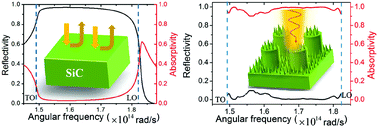Materials used for outdoor radiative cooling technologies need not only be transparent in the solar spectral region, but also need to have a broadband perfect absorption in the infrared atmospheric transparency window (infrared-ATW). Silicon carbide (SiC) has been thought to be a potential candidate for such materials. However, due to the near-perfect reflection of electromagnetic waves in the whole reststrahlen band (RB) of SiC, which is within the infrared-ATW, perfect absorption in the whole RB remains a challenge. Here by constructing a cone–pillar double-structure surface on SiC, a near-perfect absorption (>97%) of normally incident electromagnetic waves in the whole RB has been realized experimentally. Simulation results reveal that the dominant reason for the near-perfect absorption is the efficient coupling of incident electromagnetic waves into the bulk evanescent waves in the free-space wavelength range (10.33 μm, 10.55 μm) and the efficient coupling of incident electromagnetic waves into the surface phonon polaritons in the free-space wavelength range (10.55 μm, 12.6 μm). Our findings open up an avenue to enhance the absorption performance of SiC in infrared-ATW, and may lead to many new applications.
